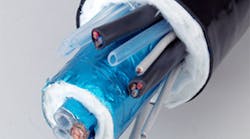All petrochemical plants have analyzer shelters or stations. These analyzers take samples of the gases and liquids in the process and test them for quality, purity, contaminants, temperature, etc. There are tubing bundles associated with the analyzers that run to sample points, which are sometimes located several hundred feet away from the analyzers. These sample tubing bundles are typically routed in cable tray. The tubing bundles are usually a composite assembly with tubing for the process sample along with electrical conductors for heat tracing and/or controls, as shown in the Photo.
Section 300.8 of the National Electrical Code (NEC) specifically states that cable tray containing electrical conductors shall not contain any pipe, tube, or equal for steam, water, gas, air, etc. or any service other than electrical. So placing these prefabricated bundles may appear to violate the requirements of the NEC. However, in the case of a prefab bundle, they are specifically made to be run as an assembly. The intent of 300.8 is that where bundles like this exist in a cable tray, you wouldn’t be allowed to run them in the same tray with any of the other wiring methods found in Table 392.10(A) without a barrier separating the bundles and the other wiring methods. In other words, either the analyzer tubing bundles need their own tray system, or a barrier must be installed between the tubing bundles and the other electrical wiring. Once you install a continuous barrier in a tray, it becomes a multiple tray even though, in essence, it is still only one cable tray.
The Photo (courtesy of Thermon) shows a custom tubing bundle with a heated core section used in a continuous emissions monitoring system.
© 2014 Fluor Corporation. All Rights Reserved.



